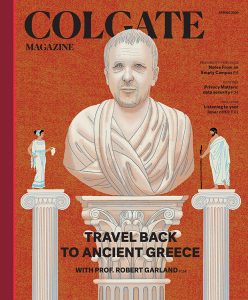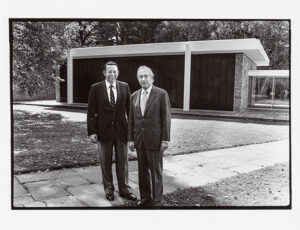Examining Prejudice

“Unpacking Perceptions” by Professor Maura Tumulty was amazing. As so many of us are reeling from the latest — George Floyd, Ahmaud Arbery — I think a lot of people are wondering what the fundamental roots of all this are. I’ve long thought that although one could argue overt prejudice is unfashionable now, we each have not done the internal homework we need to for truly eradicating the environment [in which] we’ll have more names to add to the list by the time this is published. This article hit the nail on the head: Our beliefs can be so dangerous when they stay unexamined, and whether we know it or not, they direct our personal philosophies and, therefore, our actions. I love what [Tumulty] says about “vivid imagination” too. It made me smile in reminding me of the spirituality of St. Ignatius, which also encourages imagination to free us from our “unfreedoms” (like, as Professor Tumulty points out, “negative [and unchecked] assumptions”). [The article was] great and fortunately/unfortunately very timely. I hope that I and all of us try to incorporate this more into our lives.
Henoch Fente Derbew ’07
On Colgate’s Diversity Report
I read with great interest the report on the University’s plan for diversity, equity, and inclusion going into its third century. It brought to mind my experience as a Hispanic woman at the University.
I arrived in Hamilton as the 17-year-old bride of an 18-year-old incoming black student, Raiful Tompkins ’72. Our first impression of Hamilton was jarring because the plate glass windows of the local diner featured life-sized posters of segregationist George Wallace, [then] governor of Alabama, who was [also] a candidate for president. It was the height of the Civil Rights movement and shortly after the assassination of Martin Luther King Jr. and Robert F. Kennedy.
Because we were a married couple, we lived off campus and so our social experience was quite different from students who lived and studied on the Hill. Many of the students had no close contact with minorities, and there was a feeling among us of being there to enhance their education. We developed friendships with many, but our strongest contact was with the Association of Black Collegians (ABC) upperclassmen, whom we looked to for guidance and support in this environment.
In 1968 there was a handful of black students, possibly 15. Politically, it was a tumultuous year. At Colgate, [there was] the takeover of Merrill House by the ABC in protest of the academic and social deficiencies at the University for students of color. Being present at the time during the takeover, I recall discussions between Dean Griffith and the ABC, which ended the standoff and ultimately resulted in the first facility constructed specifically for “minority” students.
I graduated from Colgate in 1973, and in the 47 years since, possibly thousands of students of color have too. While it is certainly laudable to have a diversity plan, it strikes me as odd that such a plan is even necessary considering that most graduates have gone on to successful and rewarding careers in academia, the arts, and business.
To reference the closing paragraph of the report, the eye of history is already turned upon Colgate University — for me it’s been 52 years since. While the University is to be commended for the quality of its education and the success of its graduates, it strikes a discordant note that these issues remain as relevant today as they were in 1968.
Maria Candelaria ’73
Remembering Professor Carter

As former students of Professor John Ross Carter, we were saddened to learn of his passing. We met as sophomores in Professor Carter’s seminar on the Harvard theologian Wilfred Cantwell Smith. Both of us previously had taken Carter’s class on Theravada Buddhist tradition, and Carter, apparently recognizing our gluttony for academic punishment, had encouraged us to join his seminar the coming semester.
Once a week, in the evening, we met for several hours in the classroom on the second floor of Hascall Hall to discuss the prior week’s reading. Despite the sometimes dense material, we remember those discussions fondly for their intimacy, intellectual rigor, and the friendship among the small group of us who were fortunate enough to share those evenings together. We can still remember Carter stopping on a particularly insightful phrase or observation, repeating it, and asking in his warm, purposeful, slightly Southern drawl, “Well, what do you think about that? Isn’t that saying something?”
Carter also introduced us to Chapel House, of which he was then the director, and to Buddhist meditation. And he introduced Julia to a summer program in Taiwan, which set her down a path of studying Mandarin Chinese and the lived practices of Buddhists in China.
Since graduating, we have pursued different paths. Julia continued down a path in international education; she is now an education consultant based in Shanghai and still keeps up a Vipassana meditation practice. Sam went on to study law and is now a consumer protection lawyer for the government. We both, however, were profoundly influenced by Carter’s teachings and still try to employ his lessons; in particular, to choose our words with care and to endeavor to understand the lives of others not through abstract concepts, but together, in search of common understanding, with them.
He never cajoled or demanded. He only exuded patient warmth, support, and confidence that the wisdom and strength we need already exists, and the path forward in the world will reveal itself in due time. Carter made us want to continually show up as our best selves, as scholars, and as human beings. In short, he was a friend — one whom we will miss dearly for years to come.
Julia Gooding ’08 and Sam Jacobson ’08
